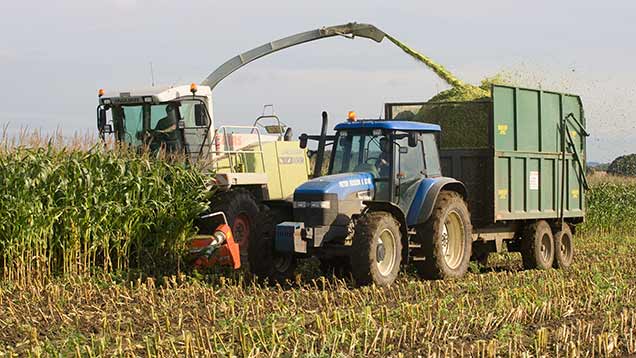Take care to balance maize silage-based dairy rations
 (c) Tim Scrivener
(c) Tim Scrivener Dairy farmers are being urged to regularly sample and test new season maize silage as they head into the new year to ensure rations remain balanced and are being used effectively.
The current lower digestibility of new-season maize silage means farmers can get away with feeding other sources of rapid fermentable energy in the ration.
For example, if producers are feeding slow-fermenting treated cereals, they may need to include rolled wheat to ensure enough fermentable energy is available.
See also: Initial maize silage analysis looks positive
However, as maize digestibility increases, failure to readdress the balance of rations could cause rumen health problems, says Mole Valley senior nutritionist Robin Hawkey.
“Maize naturally becomes more digestible the longer it has to ferment in the clamp, which could create issues with ration balance in the new year – particularly considering the amount of other starch sources on farm such as cereals, potatoes and fodder beet.
“As we start the new year and maize digestibility increases, the balance could shift the other way, so there is too much fermentable energy. If this is not addressed, there is the potential for performance to be compromised due to sub-acute ruminal acidosis (Sara),” he adds.
Early silage analysis has shown starch yields, D value and ME are all up on last year. But dry matter is higher and silage is lower in fibre and more acidic (see table). Dr Hawkey says the low fibre levels (40%) could complicate matters and farmers must pay attention to the ration’s neutral detergent fibre (NDF) levels.
“The addition of straw may help, but ensure straw is long enough to create enough physically effective NDF [peNDF], but not too long to be separated by the cow. Using a Penn State Separator will be crucial this winter to assess total ration peNDF,” he says.
Dr Hawkey also advises monitoring intakes, changes in manure consistency and milk quality. A higher average maize silage dry matter of 33% means it’s important to check the total dry matter of the diet, which should be about 50%. Any drier and this could hinder intakes and slow passage through the rumen, he says.
|
Maize silage analysis results 2013 and 2014 |
|||||||
|
Early-season maize analysis 2013 (179 samples) |
Early-season maize analyse 2014 (212 samples) |
||||||
|
Mean |
Min |
Max |
Mean |
Min |
Max |
||
|
Dry matter |
28.80 |
17.50 |
43.70 |
32.60 |
21.30 |
47.70 |
|
|
Crude protein |
83.02 |
66.81 |
96.41 |
81.83 |
69.39 |
92.30 |
|
|
NDF |
42.20 |
28.20 |
97.70 |
39.80 |
28.00 |
62.80 |
|
|
Sugar |
5.33 |
3.75 |
7.06 |
5.16 |
3.56 |
7.31 |
|
|
Starch |
27.00 |
23.60 |
43.00 |
30.00 |
15.40 |
41.80 |
|
|
Acetic acid |
11.22 |
5.07 |
23.17 |
8.92 |
5.00 |
18.99 |
|
|
Butyric acid |
3.04 |
3.00 |
4.55 |
3.03 |
3.00 |
4.69 |
|
|
Lactic acid |
11.04 |
5.00 |
65.66 |
9.47 |
5.00 |
41.74 |
|
|
ME |
11.16 |
9.55 |
11.79 |
11.26 |
10.48 |
11.95 |
|
|
pH |
3.90 |
3.50 |
4.43 |
3.83 |
3.50 |
4.45 |
|
|
DUP |
11.01 |
5.90 |
18.98 |
12.62 |
7.39 |
19.35 |
|
|
ERDP |
52.82 |
40.78 |
63.46 |
50.60 |
39.83 |
59.93 |
|
|
D |
68.46 |
58.61 |
72.33 |
69.10 |
64.27 |
73.32 |
|
|
Source: Mole Valley Feed Solutions |
|||||||
